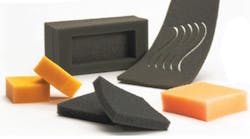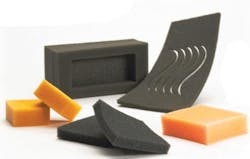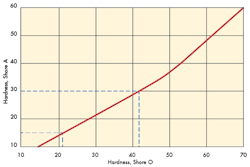Measuring the “hardness” of soft, spongy elastomers—foams—is an inexact science. There is usually a surprisingly broad spread in the data normally provided by devices such as a durometer, a tool for measuring hardness. There are also a number of variables that can scatter the readings even more. These variables include operator technique, geometry of the test specimen, and even ambient temperature and humidity.
To accommodate such variables, material specifications usually permit a tolerance of ±5 points on the scale of the measuring device. But sometimes even a 10-point spread is not enough to provide satisfactorily comparable readings on identical samples measured by technicians in different labs.
The best known device used for measuring hardness of elastomers and rubbers is the Shore A durometer. It is intended for use on materials as soft as a baby-bottle nipple or as hard as the heel of a shoe. It uses an indentor probe and works well on solid elastomers, but only on those that fall in the range of about 20 to 90 on the Shore A scale.
For measuring foam materials, the Shore A system should not be used at all. The frustum-of-a-cone indentor and high load of the device may even damage or destroy test specimens by penetration. And if the indentor probe happens to come to rest on the surface of the foam—a common occurrence when a machine component is being measured—the reading is further distorted.
To avoid these problems, engineers should use a Shore O durometer when measuring the hardness of foams. Its ball-shaped indentor is better suited for foam. And the foam should be at least 0.25 in. thick. If designers need to correlate Shore hardnesses to Shore O values, the accompanying chart uses data from the Shore Instrument Co. for making the conversions. Thus, converting a Shore A 30 ± 5 would yield a Shore O value of 42 ± 56. And a Shore O value of 21 converts to a Shore A 15—a value that would difficult to measure with the A system directly.



